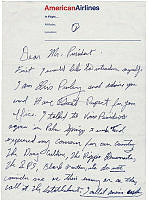Inside the Working White House: 20th Century
Copyright © White House Historical Association. All rights reserved under international copyright conventions. No part of this article may be reproduced or utilized in any form or by any means, electronic or mechanical, including photocopying, recording, or by any information storage and retrieval system, without permission in writing from the publisher. Requests for reprint permissions should be addressed to books@whha.org
Gallery
-

After working as a household manager and social secretary in New York, Elizabeth Jaffray joined the Taft White House as its housekeeper in 1909. She remained on the staff into the Calvin Coolidge administration.
Harris and Ewing (published in Literary Digest, December 1926) -

Horse-drawn carriage at South Portico, c. 1920-26. Household manager and social secretary Elizabeth Jaffray refused to adapt to the use of motor cars, and rode to market in this carriage.
The White House -

White House laundry, 1926. Three women were assigned to do the laundry by hand, and then hang it out to dry on the South Lawn, behind the kitchen.
Harris and Ewing (published in Literary Digest, December 1926) -

Copper skillet, c. 1910. When this copper skillet was in use, the White House kitchen force consisted of one cook and two helpers. The pan may have been used to prepare everything from griddle cakes and parsnip fritters to caramel custard and prune pudding for the president’s table.
Lent by The White House -

Electric call-button box, c. 1930. The earliest communication system in the White House was a set of call bells, but by the mid-1800s, the president could summon a staff member by means of an “electric” (battery-operated) device. Wiring the White House for electricity in 1891 paved the way for simple call-button boxes such as this set.
Lent by The White House
"Every day is wash-day at the White House,” housekeeper Elizabeth Jaffray recalled. The three maids assigned to the laundry when Jaffray first arrived in 1909 did not use electrical appliances; the immense amount of daily washing was done manually, then pressed with flat-irons. At least once a day, while the laundrywomen were at their tasks downstairs, a houseman ran a large carpet sweeper over the floor coverings throughout the house. A thorough vacuuming occurred each Saturday morning.
Every weekday morning at 8:30, Jaffray, who resided in the White House, consulted with the first lady about meals, personnel, and general management issues. At nine, the cook brought menus to Jaffray’s office for review. By ten o’clock, Jaffray was on her way to the market stalls to make bulk purchases of fruits, vegetables, meats, seafood, game, and butter.
The head cook and two or three assistants prepared almost all the food, not only for the president’s table, but also for receptions, state dinners, and for the servants.
Throughout the rest of the 20th century, interviews with the White House staff, diaries, memoirs, and photographs, offer capsules of the daily schedules and responsibilities that have kept the White House running. From the daily tasks of cleaning to preparing for special events such as State Dinners, the staff plays a crucial role in keeping the Executive Mansion running.
Gallery
-

One of the maintenance headaches for White House workers is the wear and tear on the wood floors. A staff member is shown here using a state-of-the-art floor sander on the East Room floor in 1955 while co-workers attend to various tasks.
National Archives and Records Administration -

Clara Richardson dusts some of the dolls collected around the world by Lynda Bird Johnson, President Lyndon B. Johnson’s daughter in 1966.
White House Historical Association -

White House floral designer Rusty Young uses a variety of colors, patterns, and designs to create a striking arrangement in the Green Room in 1966.
White House Historical Association -

Shirley Bailey, was a veteran of the hotel industry, inspects one of the White House guest rooms in 1970. The housekeeping staff makes the beds, vacuums the floors and carpets, dusts the furniture, and ensures that the White House is always looking its best.
White House Historical Association -

"When people stopped wearing dress shoes and went to soft-soled shoes we all cheered because we thought this would be great for the floors," former Chief Usher Gary Walters recalled. "We couldn't have been more wrong. What happens with soft-soled shoes is that pebbles get embedded in them, so now you've got 1,500 people walking through with sandpaper on their feet. It was exactly the opposite of what we expected." Here the East Room floor gets renovated in 1977.
The White House -

Invitations, menus, place cards, programs, and more are carefully designed and written by the White House calligrapher. Here, John Scarfone prepares the menu for the 1992 State Dinner in honor of President Patricio Aylwin of Chile.
George Bush Presidential Library and Museum/NARA
























































